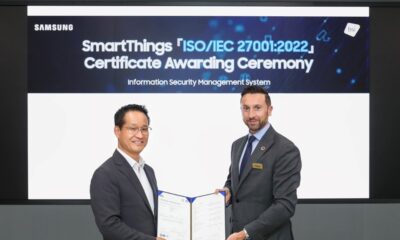News
Samsung ISOCELL JN1: World’s smallest, most versatile 50MP camera sensor is official

On June 10, 2021, Samsung launched the 50-megapixel (MP) ISOCELL JN1 as the world’s first 0.64-micrometer (μm)-pixel image sensor (smallest). This new camera sensor features the enhanced ISOCELL 2.0 pixel technology, Smart-ISO, and Double Super PDAF to capture more vivid images.
It equips ISOCELL 2.0 technology with added enhancements that improve light sensitivity by about 16%. In low light conditions, the JN1 employs Samsung’s four-to-one pixel binning tech, Tetrapixel that merges four adjacent 0.64μm-pixels into one big 1.28μm-pixel to quadruple light sensitivity for brighter 12.5Mp photographs.
Duckhyun Chang, executive vice president of the sensor business at Samsung said – “Samsung’s advanced pixel technologies have once again pushed boundaries with the utmost precision to develop an image sensor with the industry’s smallest pixel size, yet with powerful performance. The new ISOCELL JN1 at 0.64μm will be able to equip tomorrow’s sleekest smartphones with ultra-high resolution mobile photographs.”

Equipped with several advanced technologies in a small 1/2.76-inch optical format, the ISOCELL JN1 is the most versatile image sensor yet from Samsung. Besides, the JN1 is also compatible with existing 1/2.8-inch products that allow the sensor to be used not only as wide-angle but also as front-facing, ultra-wide, or telephoto cameras.
Smartphones equipped with ISOCELL JN1 will allow users to take highly detailed selfies or group pictures in an amazing 50MP resolution as well as high-resolution video at up to 4K and high-zoom ratios. Aside from the features, it can also reduce the camera module’s height by around 10% for phones’ classy back design.

ISOCELL JN1, Samsung’s most versatile image sensor
In order to enhance the dynamic range, ISOCELL JN1 is equipped with Smart-ISO, which can change the conversion gain according to the illuminance level of the environment.
Smart-ISO uses a low ISO mode in bright settings to preserve details in highlights, and a high ISO reading in low-light environments to reduce noise and produce excellent low-light performance.
Using Smart-ISO, JN1 also provides inter-scene HDR in the mixed light setting to obtain the best exposure level derived from two separate readings of low ISO and high ISO, which are required to create the final image.

For faster autofocus, the ISOCELL JN1 integrates an improved Dual Super PD. The previous Super PD technology used specially designed elliptical microlens to perform phase detection on two adjacent pixels.
The phase-detection pixel density of Double Super PD (1/16) is twice that of Super PD (1/32), and similar autofocus performance can be achieved even in environments where illumination levels are reduced by about 60%.
For smooth, crystal-clear video, the image sensor supports recording 4K resolution video at 60 frames per second (fps) or recording Full HD video at 240fps.
- Samsung said – The Samsung ISOCELL JN1 is currently in mass production.
STAY CONNECTED WITH US:
- Join SammyFans on Telegram
- Like SammyFans.com on Facebook
- Follow SammyFans on Twitter
- Get news in graphics on Instagram
- Get the latest insights through Google News
- Send us tips at – [email protected]
News
Here’s why Google Messages replaced Samsung Messages on Galaxy devices

Samsung’s latest foldable phones come with Google Messages by default. The company has now revealed the reason behind this move on Galaxy devices. Samsung says Google Messages replaced Messages to foster RCS adoption.
According to AndroidAuthority, a source explained Samsung’s decision to switch to Google Messages as the default messaging app. The recently released Galaxy Z Flip 6 and Z Fold 6 come with Google Messages with RCS enabled by default.
Looks like promoting Google Messages on Galaxy devices will boost RCS adoption. Samsung Messages isn’t already installed on newer phones. However, one’s stopping you from getting it on your Galaxy from the Galaxy Store.
While many apps support the RCS feature, Google Messages offer the best user experience. Making it a default messaging app is an effort to boost the adoption of RCS tech. Apple is also preparing to bring RCS chat functionality to iMessage for iPhones.
What Samsung source said:
- Even if messaging apps follow the RCS standard, the availability may be limited depending on which app the other party uses. That’s why we decided to make Google Messages the common messaging platform, allowing Galaxy users to communicate more freely. This also enables a messaging app to respond to changes of the RCS standard more quickly and efficiently.
Previously, Samsung devices launched in the US came with two messaging apps. This time, the company has removed the Samsung Messages. During the first setup, users are notified that Google Messages is the default messaging application.
News
Samsung SmartThings gets ISO 27001 certified

Samsung SmartThings gained the international standard ISO/IEC 27001:2022 certification. The company has officially announced this major development in its global connected living platform.
SmartThings received ISO/IEC 27001:2022 certification for information security management systems. Certification reiterates that the SmartThings Cloud operates per international standards.
To be certified, a company has to meet the standard across a total of 123 detailed items, including policies for information security, access control for information assets, and incident response.
SmartThings receiving the ISO 27001 certification is the result of our sustained focus on the protection of information in a hyper-connected world with exponentially increasing intelligence.
Seungbum Choi, Executive Vice President and Head of Device Platform Center at Samsung Electronics said “this is just another step in our drive to fortify the platform’s security. We will continue to find new ways to ensure that SmartThings’ personalized services are provided even more safely.”

BSI Prez says that they have recognized that the operation capability and security level of Samsung SmartThings is excellent. It will further boost trust in the SmartThings platform and strengthen business competitiveness.
ISO 27001 is the leading global standard for ISMSs and was established by the International Organization for Standardization. It provides companies with guidance to manage the risks to information assets systematically and achieve information protection goals.
News
Dr.diary fuels Samsung Health with glycated hemoglobin algorithm
Samsung Health app integrated the Dr.diary (Doctor Diary) glycated hemoglobin feature. The blood sugar management platform announced the launch of its glycated hemoglobin estimation functionality on Samsung’s Health application.
According to ETNews, Dr.diary announced the integration of a glycated hemoglobin level feature in Samsung Health. Galaxy users will now be able to check the estimated glycated hemoglobin level provided by Doctor Diary.
To activate the feature, Health app users will have to permit certain conditions of data in the Blood Sugar service. It is worth noting that glycated hemoglobin is a key figure for diabetes diagnosis, which users will find worth using in the Health app.
Established in 2017, Dr.diary is a blood sugar management platform. It analyzes and predicts the changes in glycated hemoglobin using its own algorithm. Earlier this year, the firm secured a patent for “glycated hemoglobin estimation based on blood sugar data table.”
Song Je-yoon, CEO of Doctor Diary, said, “With our predicted glycated hemoglobin level prediction algorithm being installed in Samsung Health, more people will be able to recognize their glycated hemoglobin level and manage their health more efficiently.”

Glycated hemoglobin (HbA1c) is a standardized numerical value of the percentage of hemoglobin, such as hemoglobin, which has been glycated by glucose. Glycated hemoglobin reflects the average blood sugar level over the past 2-3 months.
Samsung Health (with Wear OS Galaxy Watch) users can conveniently check their estimated glycated hemoglobin level within the app and use this information to manage their blood sugar levels through diet and exercise.












